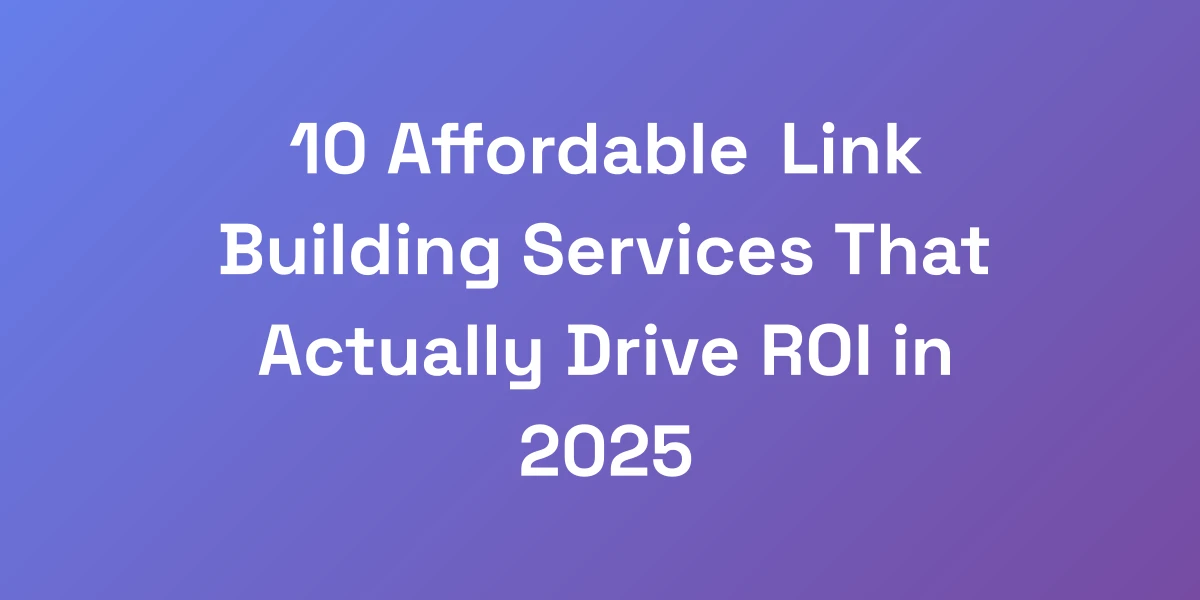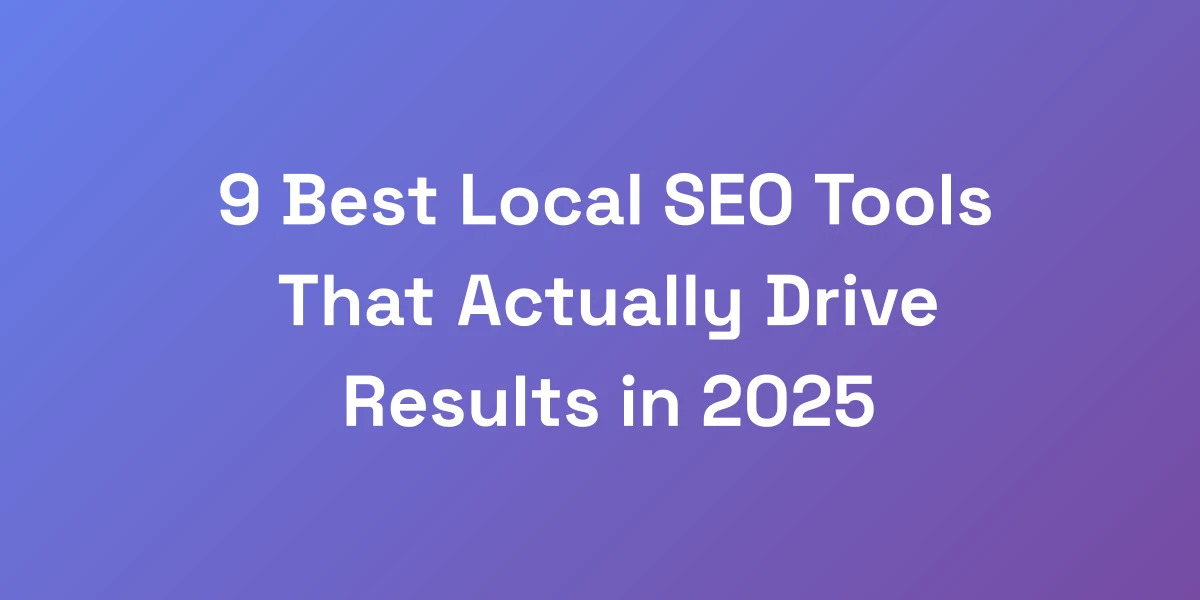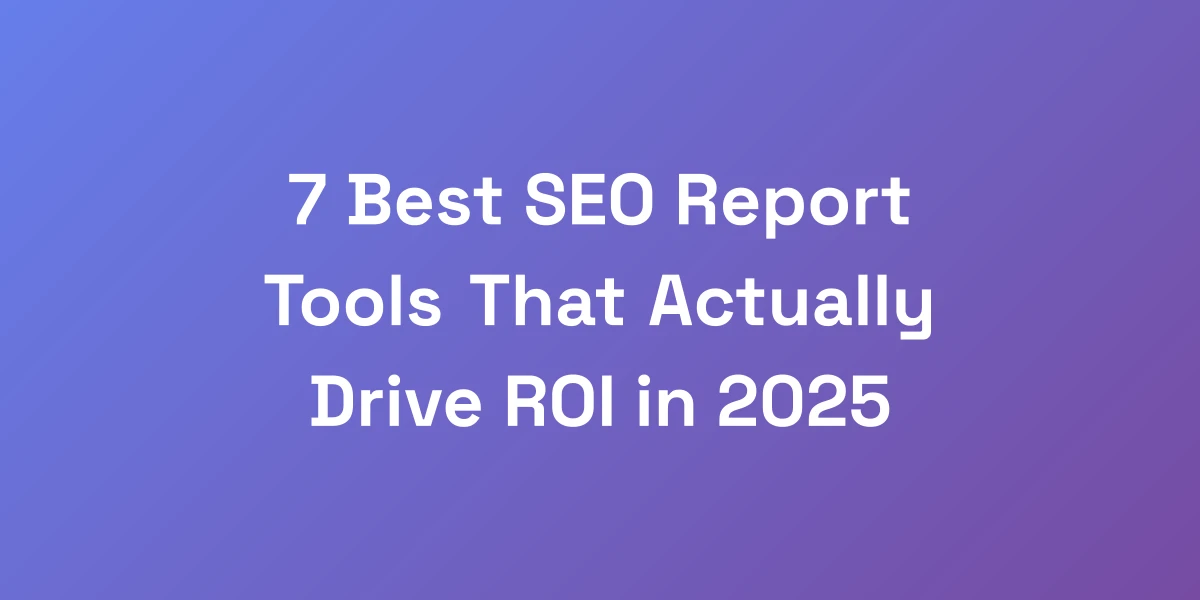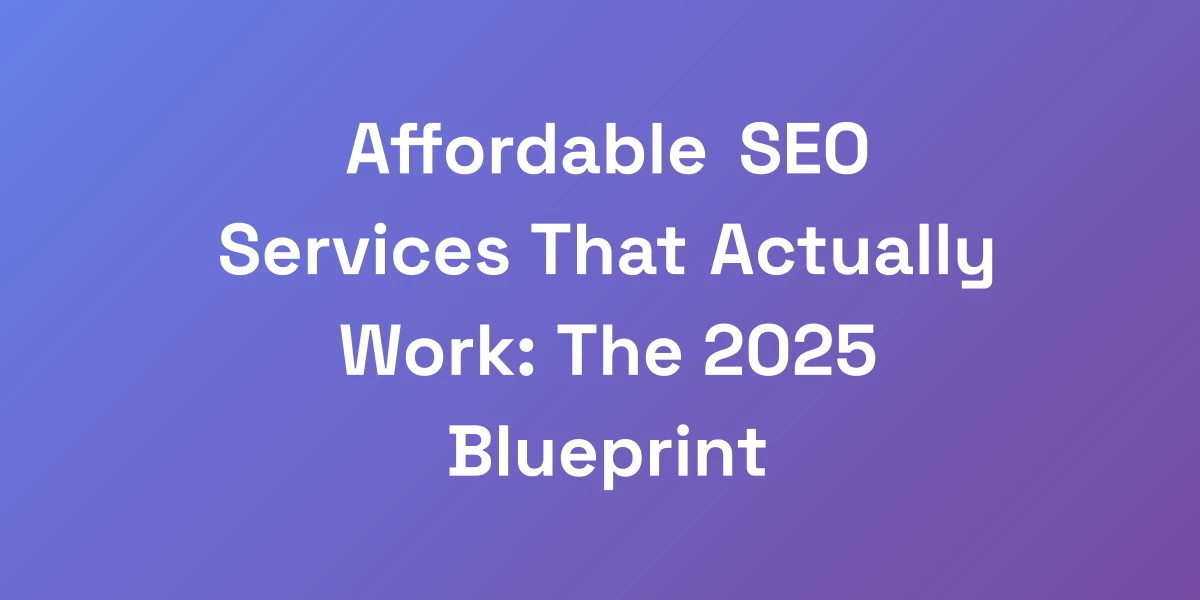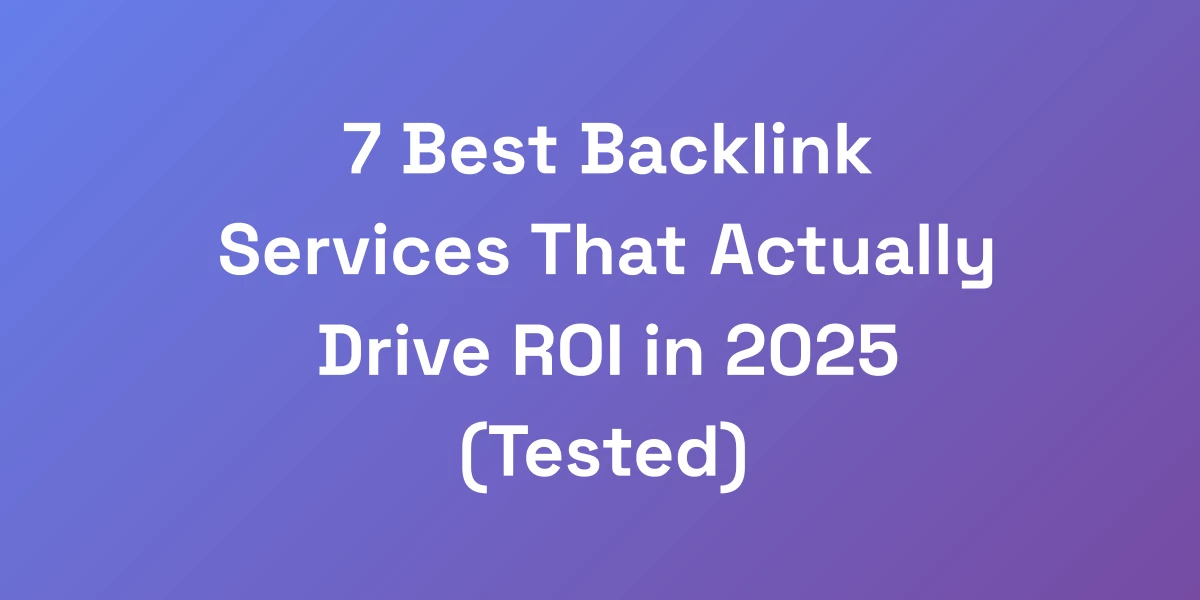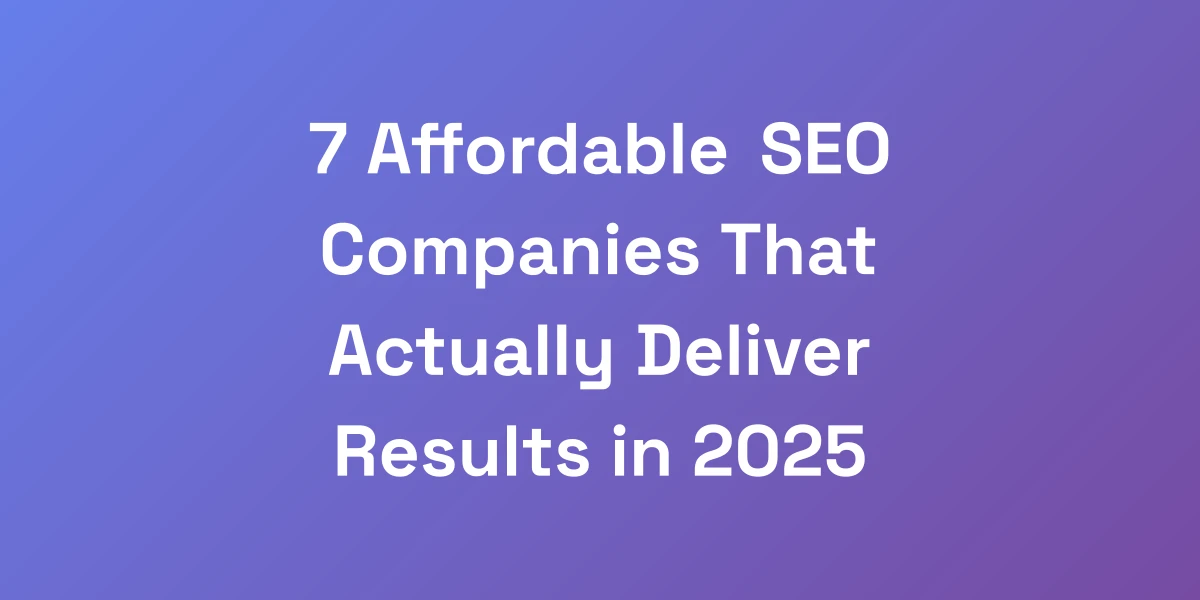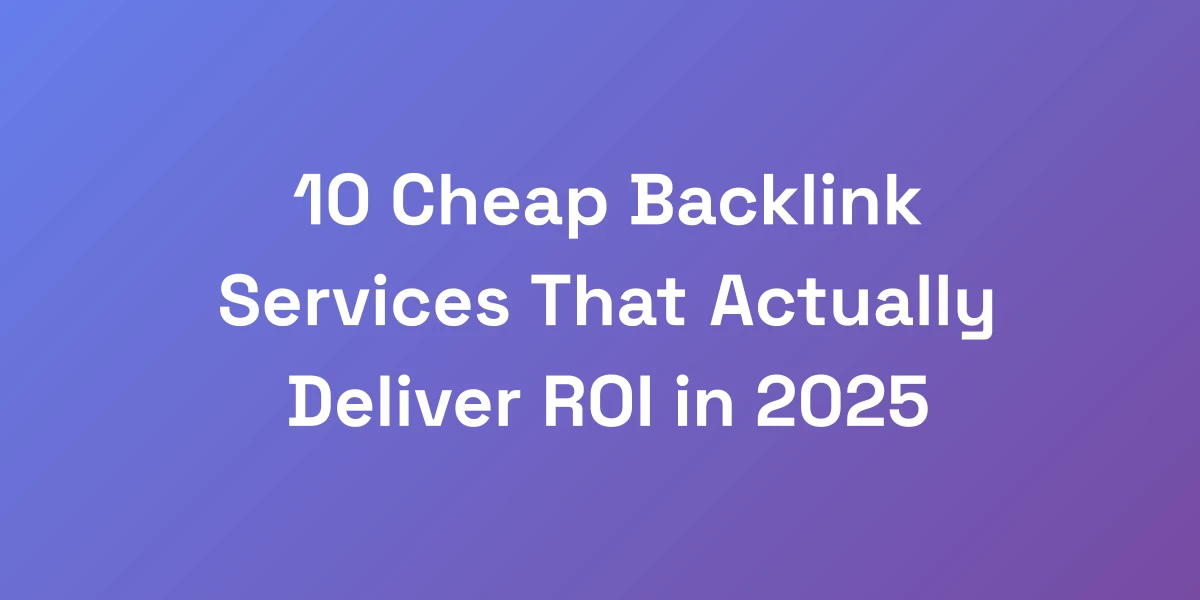
Affordable Local SEO Services That Actually Drive ROI in 2025
Mar 3, 2025 | By [email protected]
The Truth About “Affordable” Local SEO Services
Let me be brutally honest with you – we’ve seen too many businesses get burned chasing the cheapest local SEO services.
Here’s the raw truth: you don’t need to spend thousands to get results, but you also can’t expect magic from $99/month packages.
What you need is strategic investment in services that generate actual returns.
Through our experience scaling multiple 8-figure businesses, we’ve identified exactly what makes local SEO services worth every penny – and we’re about to show you how to spot the difference between a bargain and a costly mistake.
Why Most Cheap Local SEO Services Fail
Cheap local SEO services often promise the moon but deliver dust. Why? Because they focus on quantity over quality.
They might offer high volumes of low-quality backlinks or keyword stuffing, which not only fails to improve your rankings but can also harm your site’s reputation.
Think of it like hiring a plumber who uses cheap materials – it might seem cost-effective initially, but the long-term damage will cost you more.
Instead of quick fixes, successful local SEO requires a focus on sustainable, high-impact strategies that build your online presence authentically.
The Real Cost of Poor SEO Implementation
Investing in poor SEO implementation can be more damaging than not investing at all.
Businesses often waste months watching their rankings stagnate or decline, leading to lost opportunities and revenue.
Consider the example of a local restaurant that spent heavily on ineffective SEO, only to see a drop in online visibility.
Not only did they fail to attract new customers, but their existing ones also struggled to find accurate information online.
The real cost? Lost sales, decreased customer trust, and a tarnished brand reputation.
Defining “Affordable” in Local SEO Context
When we talk about “affordable” local SEO, we’re not just talking about the lowest price tag.
It’s about getting the best value for your investment – strategies that provide a significant return without breaking the bank.
Affordable doesn’t mean cheap; it means efficiently allocating your budget to the most impactful areas.
For instance, a local business should prioritize Google Business Profile optimization over less effective tactics.
This ensures every dollar spent contributes directly to boosting visibility and driving sales.
ROI Metrics That Actually Matter
Focusing on the right ROI metrics is crucial for assessing the effectiveness of your local SEO efforts.
Here are the metrics that truly indicate success:
- Organic Traffic Growth: Monitoring the increase in visitors from search engines.
- Conversion Rates: The percentage of visitors who take a desired action, like making a purchase or booking a service.
- Local Pack Rankings: Your position in the local search results, particularly in the coveted “Local Pack.”
- Return on Investment (ROI) Calculation: Comparing the cost of SEO services to the revenue generated from those efforts.
- Customer Engagement: Metrics such as time spent on site and bounce rates indicate how well your content resonates with visitors.
By focusing on these metrics, you ensure that your SEO strategies are driving real business growth.
Red Flags in Budget SEO Offerings
Not all that glitters is gold, especially in the SEO world.
Here are some red flags to watch out for when evaluating budget SEO offerings:
- Guaranteed Rankings: SEO is complex and unpredictable. No reputable agency can guarantee top rankings.
- One-Size-Fits-All Packages: Your business is unique, and your SEO strategy should be too. Generic packages lack customization.
- Lack of Transparency: If the agency isn’t clear about their methods or pricing, steer clear.
- Overemphasis on Link Building: While backlinks are important, overdoing it with low-quality links can harm your site.
- No Clear Reporting: A good SEO provider should offer detailed reports showing progress and results.
Being aware of these red flags helps you avoid costly mistakes and choose a provider that genuinely adds value to your business.
Core Components of Effective Local SEO Services
Stop wasting money on random SEO activities that don’t move the needle. The key to affordable local SEO is focusing on high-impact elements that directly influence your bottom line.
I’m talking about the 20% of optimization efforts that drive 80% of results. From our experience building and scaling businesses, these core components consistently deliver the highest ROI when implemented correctly.
Let’s break down exactly what services you should be paying for and why they matter for your local business success.
Google Business Profile Optimization
Your Google Business Profile is often the first thing potential customers see. How to optimize Google My Business is non-negotiable.
Here’s how to make the most of it:
- Complete Your Profile: Fill out every section, including business description, hours, and services.
- Use Relevant Keywords: Incorporate local keywords naturally into your description to improve searchability.
- High-Quality Images: Upload professional photos that showcase your business and products.
- Regular Updates: Post updates about offers, events, and news to keep your profile active and engaging.
Businesses that optimize their profiles effectively see a 70% increase in visibility and attract more local customers through enhanced search presence.
Local Citation Building and Management
Local citations are online mentions of your business’s name, address, and phone number (NAP). Consistency here is key.
To build and manage citations effectively:
- List on Major Directories: Ensure your business is listed on platforms like Yelp, Yellow Pages, and local business directories.
- Maintain NAP Consistency: Your business information must be identical across all listings to avoid confusion and penalties.
- Monitor and Update: Regularly check your citations for accuracy and make updates as needed.
Proper citation management can significantly boost your local search rankings and drive more traffic to your business.
Location-Based Content Strategy
Content is king, but location-specific content reigns supreme in local SEO. Incorporating dynamic content marketing strategies can further enhance your content’s effectiveness.
Here’s how to create a winning location-based content strategy:
- Create Localized Content: Write blog posts, articles, and pages tailored to your local audience’s interests and needs.
- Incorporate Local Keywords: Use keywords that reflect your geographical area to improve local search visibility.
- Highlight Local Events and News: Engage with your community by featuring local events and news relevant to your business.
- Use Structured Data: Implement schema markup to help search engines better understand your content and location.
A strong location-based content strategy not only enhances your SEO but also establishes your authority in the local market.
Review Generation and Management
Reviews are a powerful trust signal for both search engines and potential customers.
Effective review generation and management involve:
- Encouraging Customer Reviews: Ask satisfied customers to leave positive reviews on your Google Business Profile and other relevant platforms.
- Responding to Reviews: Engage with reviewers by responding to both positive and negative feedback professionally.
- Monitoring Review Sites: Keep an eye on various review sites to stay informed about customer sentiment and address issues promptly.
Businesses that actively manage their reviews see increased trust and higher conversion rates, driving more revenue.
Local Link Building Essentials
Quality backlinks from local sources can significantly enhance your local SEO.
Here’s how to build effective local links:
- Partner with Local Businesses: Collaborate with other local businesses for mutual linking opportunities.
- Engage with Local Media: Get featured in local news outlets, blogs, and industry publications.
- Attend Local Events: Sponsoring or participating in local events can earn you valuable backlinks and local exposure.
- Create Shareable Content: Develop content that local websites find valuable and want to link to, such as guides, infographics, or case studies.
Effective local link building not only boosts your local search rankings but also drives targeted traffic to your site.
How to Evaluate Local SEO Service Providers
Listen, we’ve worked with dozens of SEO agencies, and we’ll tell you exactly what separates the winners from the time-wasters.
The key is knowing what questions to ask and what results to demand.
Most business owners get this completely wrong – they focus on vanity metrics instead of actual business impact.
We’re going to show you our proven framework for identifying SEO partners who can deliver real results without breaking the bank.
This is the same process we’ve used to vet partners for multiple seven-figure businesses.
Essential Questions to Ask Providers
When evaluating local SEO providers, here are the essential questions to ask:
- What is your experience with local SEO? Ensure they have a solid track record of working with businesses in your industry and location.
- Can you provide case studies or references? Ask for real examples of how they’ve helped other clients achieve their goals.
- What strategies do you use? Their response should cover all core components like Google Business Profile optimization, citation building, and content strategy.
- How do you measure success? They should focus on meaningful metrics like organic traffic, conversion rates, and ROI.
- What is included in your pricing? Ensure transparency in what services are provided and avoid hidden fees.
These questions help you gauge the provider’s expertise and ensure they align with your business objectives.
Understanding Service Deliverables
Clear deliverables are crucial for measuring the success of your SEO investment.
Here’s what to look for:
- Detailed Reporting: Regular updates on progress, including key metrics and insights.
- Specific Actions: Concrete tasks like optimizing your Google Business Profile, building citations, and creating content.
- Timeline: A clear roadmap of what to expect and when.
- Customization: Tailored strategies that address your specific business needs and goals.
Understanding the deliverables ensures that you know exactly what you’re paying for and how it contributes to your growth.
Analyzing Past Performance and Case Studies
A provider’s past performance is a strong indicator of future success.
Here’s how to analyze it:
- Review Case Studies: Look for detailed examples of how they’ve improved other businesses’ local SEO.
- Check Client Testimonials: Genuine feedback from previous clients provides insight into their effectiveness and reliability.
- Assess Long-Term Results: Focus on providers who have demonstrated sustained success, not just quick wins.
Real-life examples, like a restaurant chain increasing its revenue by 270% through strategic local SEO, showcase the provider’s capability to deliver substantial ROI.
Contract Terms and Guarantees
Before signing on with an SEO provider, scrutinize the contract terms and guarantees they offer.
Key elements to consider:
- Duration: Understand the length of the contract and any penalties for early termination.
- Service Guarantees: Reputable agencies won’t guarantee specific rankings, but they should promise transparency and continuous improvement.
- Payment Terms: Ensure the payment schedule is clear and aligns with the delivery of services.
Clear and fair contract terms protect your investment and ensure that the provider remains committed to delivering results.
Communication and Reporting Standards
Effective communication is essential for a successful partnership with your SEO provider.
Here’s what to look for:
- Regular Updates: Weekly or monthly reports that detail progress, challenges, and upcoming tasks.
- Accessibility: Easy access to your account manager for questions and support.
- Transparency: Open discussions about strategies, results, and adjustments needed to optimize performance.
Leveraging automated SEO reporting systems can save time and provide accurate data. Consistent and clear communication ensures that you’re always in the loop and can make informed decisions about your SEO strategy.
Pricing Models and Package Comparison
Here’s what nobody in the SEO industry wants to tell you: the price you pay should be directly tied to your potential return.
We’ve seen businesses waste thousands on overpriced services, and others get incredible ROI from modest investments.
The key is understanding what you’re actually paying for and how it translates to business growth.
We’re about to break down the exact pricing structures that make sense for different business types and growth stages.
Monthly Retainer vs. Project-Based Pricing
Understanding the difference between monthly retainers and project-based pricing is crucial.
- Monthly Retainer: This model involves ongoing services for a set fee each month. It’s ideal for businesses looking for continuous SEO support and improvements.
- Project-Based Pricing: Pay for specific projects or campaigns. This is suitable for businesses with defined goals or one-time needs, like a website overhaul or a specific marketing campaign.
Choosing the right model depends on your business objectives and how consistently you need SEO services.
What Should Be Included at Each Price Point
Different price points offer different levels of service. Here’s a breakdown:
- Basic Packages ($200-$500/month):
- Google Business Profile Optimization
- Basic Citation Building
- Monthly Reporting
- Mid-Tier Packages ($500-$1500/month):
- Comprehensive Local SEO Services
- Advanced Citation Management
- Content Creation and Optimization
- Review Management
- Premium Packages ($1500+/month):
- Full-Service Local SEO
- Local Link Building
- Advanced Analytics and Reporting
- Dedicated Account Management
Ensure that each package level aligns with your business needs and provides the necessary services to drive ROI.
Hidden Costs to Watch Out For
Be vigilant about hidden costs that can inflate your SEO budget unexpectedly.
- Setup Fees: Some providers charge one-time setup fees that aren’t always disclosed upfront.
- Add-On Services: Services like content creation or advanced analytics may come at an additional cost.
- Long-Term Contracts: Locking into long-term contracts without flexibility can lead to higher costs if you need to make changes.
Always ask for a detailed breakdown of costs to avoid surprises down the road.
ROI Calculation Framework
Calculating ROI for your local SEO investment involves comparing the costs to the revenue generated from SEO efforts.
Here’s a simple framework:
- Determine Total Investment: Include all costs related to SEO services, including any additional fees.
- Measure Revenue Generated: Track the revenue directly attributed to SEO efforts, such as increased sales from organic traffic.
- Calculate ROI: Use the formula (Revenue – Investment) / Investment x 100 to get your ROI percentage.
This framework helps you understand the financial impact of your SEO efforts and make informed decisions about future investments.
Scaling Services as You Grow
Your SEO needs will evolve as your business grows. Scaling your services ensures that your SEO strategy continues to support your expansion.
- Incremental Services: Add more services like advanced link building or comprehensive content strategies as your budget allows.
- Geographical Expansion: Expand your local SEO efforts to new locations as you open new branches or target new markets.
- Enhanced Reporting: Upgrade to more detailed analytics and reporting to gain deeper insights as your data grows.
Scaling effectively ensures that your SEO strategy remains aligned with your business growth and continues to deliver strong ROI. Additionally, utilizing SEO automation tools can streamline your scaling efforts, making it easier to manage increased complexity without proportionally increasing your workload.
Implementation Timeline and Expected Results
Let’s cut through the BS – real SEO results take time, but that doesn’t mean you should wait forever.
From our experience scaling multiple businesses, we can tell you exactly what results to expect at each stage of your local SEO journey.
We’re going to lay out a realistic timeline that helps you avoid both unrealistic expectations and unnecessary delays.
This is the same framework we’ve used to track progress and ensure ROI across multiple ventures.
Month-by-Month Progress Markers
Mapping out month-by-month progress helps set realistic expectations.
- Month 1: Setup and initial optimization – Google Business Profile, basic citations, initial keyword research.
- Month 2-3: Content creation and advanced citation building – starting to build a content library and enhance local citations.
- Month 4-6: Link building and review management – acquiring quality backlinks and actively managing customer reviews.
- Month 7-12: Continuous optimization and scaling – refining strategies based on performance data and expanding efforts as needed.
This timeline ensures steady progress without the frustration of waiting indefinitely for results.
Key Performance Indicators (KPIs)
Tracking the right KPIs is essential for measuring the success of your SEO strategy.
- Organic Traffic Growth: Monitoring the increase in visitors from search engines.
- Conversion Rates: Assessing the percentage of visitors taking desired actions.
- Local Pack Rankings: Tracking your position in local search results.
- Customer Reviews and Ratings: Measuring the quantity and quality of customer feedback.
- Return on Investment (ROI): Calculating the financial return from SEO efforts.
Focusing on these KPIs helps you stay aligned with your business goals and make data-driven decisions.
Common Implementation Challenges
Implementing a local SEO strategy isn’t without its challenges.
- Competition: High competition in your local market can make it harder to achieve top rankings.
- Consistency: Maintaining consistent NAP information across all directories requires ongoing effort.
- Content Creation: Producing high-quality, location-specific content can be time-consuming.
- Algorithm Changes: Staying updated with search engine algorithm changes to ensure your strategy remains effective.
- Resource Allocation: Balancing SEO efforts with other business priorities can be challenging.
Being aware of these challenges allows you to proactively address them and keep your SEO strategy on track.
Measuring Success Milestones
Setting and measuring success milestones keeps your SEO efforts focused and goal-oriented.
- Initial Ranking Improvement: Seeing early gains in keyword rankings within the first few months.
- Traffic Increases: Noticing a steady rise in organic traffic as your SEO strategies take effect.
- Higher Conversion Rates: Achieving increased conversions from improved visibility and targeted traffic.
- Enhanced Brand Visibility: Greater presence in local search results and recognition within your community.
- Positive ROI: Demonstrating clear financial returns from your SEO investment.
These milestones help you gauge progress and ensure that your SEO strategy is driving the desired outcomes.
When to Expect ROI
While SEO is a long-term investment, knowing when to expect ROI can help manage expectations.
- Short-Term (3-6 months): Initial improvements in local rankings and organic traffic.
- Mid-Term (6-12 months):strong> Significant increases in traffic, conversions, and revenue.
- Long-Term (12+ months):strong> Sustained growth, brand authority, and consistent ROI from ongoing SEO efforts.
Patience and consistency are key. Realistic expectations ensure you stay committed to your SEO strategy for maximum returns.
Conclusion
Investing in affordable local SEO services is not just about cutting costs; it’s about making a strategic move that drives real, measurable returns.
We’ve dissected the truth behind affordable SEO, identified the core components that matter, and provided a clear framework for evaluating and implementing these services effectively.
The key takeaways are simple: focus on high-impact strategies, choose the right SEO partners, and maintain consistent efforts to see substantial ROI.
If you’re ready to take your local business to the next level, it’s time to invest wisely in SEO services that deliver.
Don’t just chase the cheapest options – seek out providers that understand your unique needs and can tailor their services to drive your business growth.
Ready to boost your local presence and see tangible results? Contact us today to start your journey towards higher visibility and increased revenue.
What challenges have you faced with local SEO, and how did you overcome them? Share your experiences in the comments below – we’d love to hear from you!
